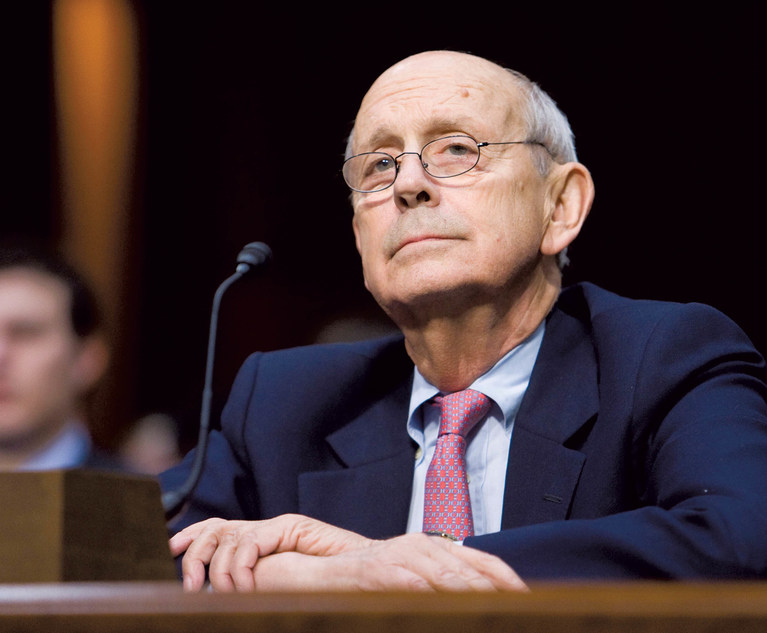Thank you for reading The Marble Palace Blog, which I hope will inform and surprise you about the Supreme Court of the United States. My name is Tony Mauro. I’ve covered the Supreme Court since 1979 and for ALM since 2000. I semiretired in 2019, but I am still fascinated by the high court. I’ll welcome any tips or suggestions for topics to write about. You can reach me at [email protected].
Supreme Court Justice Stephen Breyer, who plans to retire soon, will be remembered fondly, most of the time, for his fanciful hypotheticals and sometimes marathon-length questions during oral arguments.
In the 2016 case Heffernan v. City of Paterson, New Jersey, Breyer served up one of his more creative hypotheticals in a First Amendment dispute. He posited a law that states “no one can espouse in a public place the political philosophy of Ruritanianism.” Advocates could be excused if they did not know that Ruritania is a fictional country in Europe.
Another case in point: the 2009 Fourth Amendment case Safford Unified School District v. Redding, involving an eighth-grade girl who was strip-searched by school officials to determine if she had ibuprofen on her person.
Breyer recalled his own youth when it would have seemed logical to hide contraband wherever possible to avoid punishment. “In my experience, people did sometimes stick things in my underwear,” Breyer said. As the audience erupted in laughter, Breyer quickly corrected himself: “Or not my underwear. Whatever. Whatever. …. I mean I don’t think it’s beyond human experience.”
Justice Ruth Bader Ginsburg didn’t find it funny, later telling USA Today that her male colleagues “have never been a 13-year-old girl. … It’s a very sensitive age for a girl. I didn’t think that my colleagues, some of them, quite understood.”
The 2018 argument in Republic of Sudan v. Harrison may take the prize for Breyer’s lengthy questions. It involved a huge judgment against Sudan for the victims of the USS Cole bombing in 2000, the fate of which depended on whether notice of the litigation was sent to the wrong address.
Veteran advocate Kannon Shanmugam, now with Paul, Weiss, Rifkind, Wharton & Garrison, but then with Williams & Connolly, represented the victims. He argued that the pertinent statute, while it may be ambiguous, does not prohibit service by mail to an embassy. He ran into skepticism from several justices, but none more than Breyer.
Breyer launched into a lengthy discourse revealing his multiple concerns, as well as the research done by one of his law clerks, who found that 22 to 27 countries require service to their foreign ministry, not to embassies. The question took up 69 lines and more than three pages of the court transcript, and more than 10% of Shanmugam’s 30-minute oral argument time.
Breyer ended his soliloquy with this: “Now I put that long question to you because I want to give you a chance to say no, I’m wrong, there are 32 countries who do it differently, or whatever you want to say.”
Without hesitation, Shanmugam replied, “Well, I’m not going to say you’re wrong, Justice Breyer, but I will address what I think were really the three parts of your question: first, text; second, policy; and, third, the practice of other countries.” He proceeded to discuss each of those parts.
Carl Cecere, a solo appellate practitioner from Dallas who watched the argument and filed an amicus on Shanmugam’s side, said this afterward: “Kannon’s answer was marvelous. He not only remembered each part of the question and organized a coherent response—itself a challenge. He turned each of Justice Breyer’s concerns into a point in his favor.”
On Wednesday, Shanmugam tweeted, “Many memorable moments over the years appearing in front of Justice Breyer, but I’ll never forget the time he asked me a three-page-long question.”
NOT FOR REPRINT
© 2024 ALM Global, LLC, All Rights Reserved. Request academic re-use from www.copyright.com. All other uses, submit a request to [email protected]. For more information visit Asset & Logo Licensing.


 Justice Stephen Breyer. Photo: Diego M. Radzinschi/ALM
Justice Stephen Breyer. Photo: Diego M. Radzinschi/ALM







